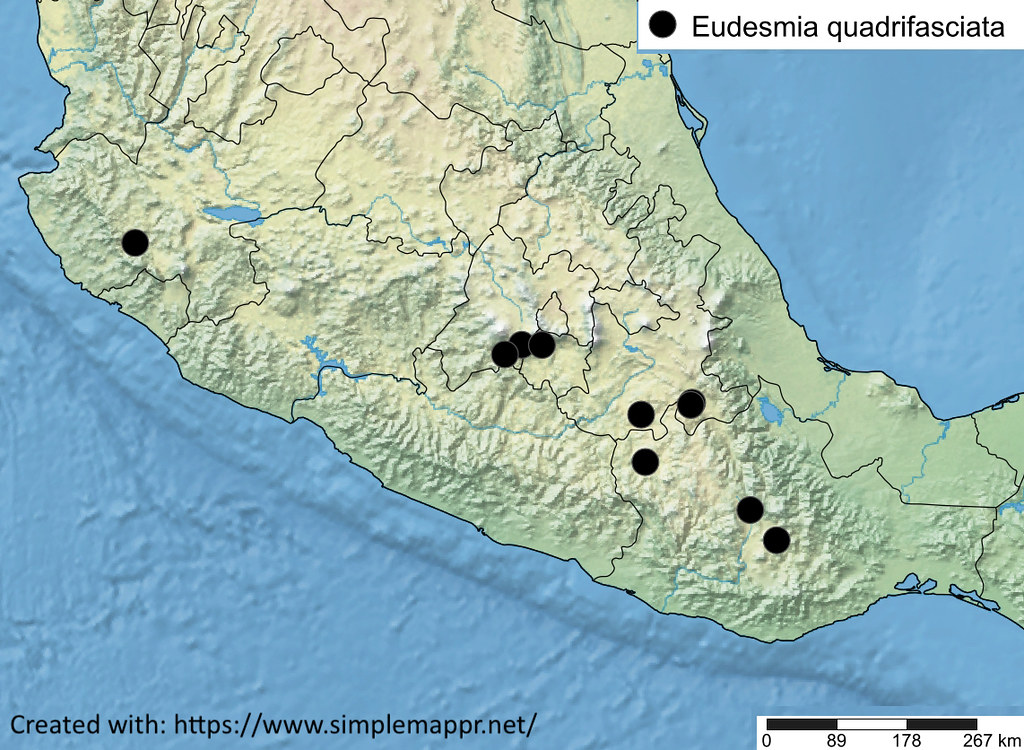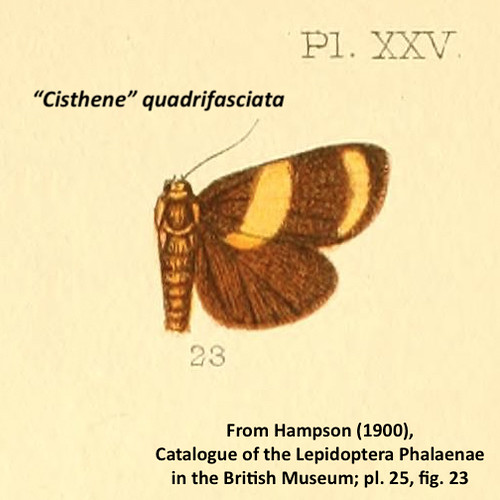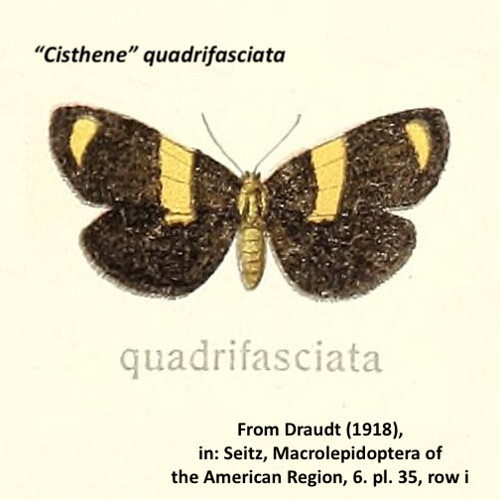Recognizing Eudesmia quadrifasciata of southern Mexico
Resumen (español): Eudesmia quadrifasciata es muy similar a E. arida. Su principal carácter distintivo, la mayor parte de las alas traseras negras, no es evidente en las fotos de campo. Las diferencias sutiles en la forma de la mancha subterminal en las alas anteriores pueden ayudar a distinguir la especie; esta mancha es más corta y más en forma de lágrima en quadrifasciata que en arida. Los rangos de las dos especies están muy separados. E. quadrifasciata se encuentra desde el estado de México al sur hasta Oaxaca.


Eudesmia quadrifasciata: Acatlán, Puebla @hildeberto | Zapotitlán, Puebla @bsullend


Eudesmia quadrifasciata: Ixtapan de la Sal, México @mizrain | Zapotitlán, Puebla @monitorzapotitlansalinas
The lichen moth Eudesmia quadrifasciata (Erebidae: Arctiinae) is very similar to E. arida of northern Mexico and the southwestern United States. Walker (1865) described "Gerba quadrifasciata" from Oaxaca, Mexico, from a single male specimen. It's primary distinguishing character is the mostly black hindwing with just a small basal spot of orange, a character that will be unrecognizable in most field photos. Other than this aspect, Walker's brief original description does not allow for handy discrimination from most other Eudesmia which occur in Mexico. Of note, however, Walker did mention that the subterminal crescent "narrows towards the interior angle, which it does not reach." Hampson's (1900) redescription of quadrifasciata and illustration of the type (below) indicate that the subterminal crescent runs from "just below the costa to just below vein 2", i.e., somewhat shorter than the more northern E. arida and unlike E. menea. The illustration of E. quadrifasciata by Hampson (1900, pl. 25, fig. 23, below, left) shows a forewing that is probably indistinguishable from that of E. arida but Draudt's illustration (1918, pl. 35, row i, below, right) emphasizes that the subterminal crescent is short and teardrop-shaped (thicker anteriorly, narrowed posteriorly). As with populations of other species/phenotypes, the hue of the color bands and their widths vary quite a bit within the small available set of images. None of the available images on iNaturalist shows a view of the hindwing or abdomen.
Among iNaturalist observations as of 20 December 2022, I identified 9 observations in the Mexican states of Oaxaca, Puebla, Morelos, and Mexico which have a distinct short, teardrop-shaped subterminal crescent (map, below). An additional somewhat disjunct record in the state of Jalisco appears to be of the same phenotype:

Dyar's (1917) "Cisthene" [= Eudesmia] tehuacana, described from Tehuacán in the state of Puebla, Mexico, apparently differs from E. quadrifasciata only in that the abdomen is "black above, except at base and tip". I expect this is just a regional variant of E. quadrifasciata.
References:
Draudt, M. 1918. 61. Genus: Cisthene Wkr. Pp. 273, In: A. Seitz, The Macrolepidoptera of the world: a systematic account of all the known Macrolepidoptera. Division II: The Macrolepidoptera of the American Region, Vol. 6. The American Bombyces and Sphinges. Publ. 30, XI, 1918.
Dyar, H. G. 1917. A note on Cisthene. Ins. Insc. Menstr. 5:8-10.
Hampson, G. F. 1900. Catalogue of the Lepidoptera Phalaenae in the British Museum. Vol. 2. Catalogue of the Arctiadae (Nolinae, Lithosianae) in the Collecion of the British Museum. London. 589 p.
Walker, F. 1864 [1865]. List of the Specimens of Lepidopterous Insects in the Collection of the British Museum. Part XXXI--Supplement. Printed by order of the Trustees, London.































Comentarios
Chuck, thank you for the journal posting along with the ID. I look forward to meeting you one day. We can talk buugs!
Agregar un comentario